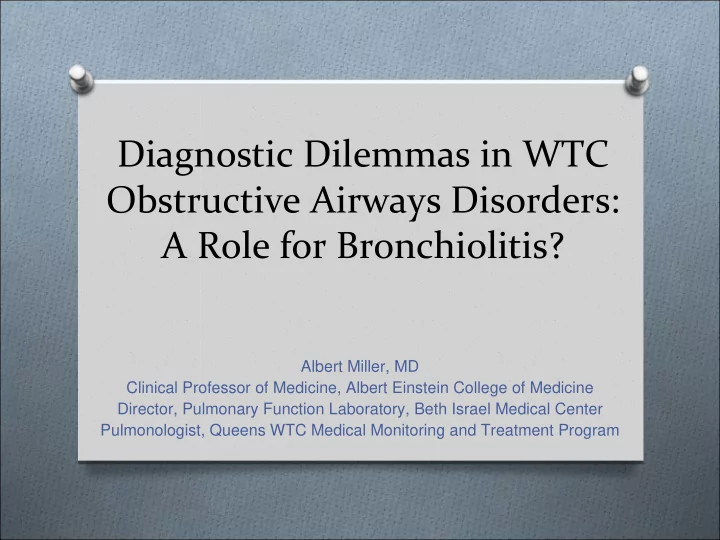

Diagnostic Dilemmas in WTC Obstructive Airways Disorders: A Role for Bronchiolitis? Albert Miller, MD Clinical Professor of Medicine, Albert Einstein College of Medicine Director, Pulmonary Function Laboratory, Beth Israel Medical Center Pulmonologist, Queens WTC Medical Monitoring and Treatment Program
From my viewpoint, with 50 years as a pulmonologist with particular experience in normative standards, pfts, occupational and environmental lung disease and sarcoidosis, I present several cases of WTC airways disease followed at the Queens Center. Each makes a particular point, raises a critical question, or suggests the diagnosis of bronchiolitis.
Case 1: 47 M, Atopic Asthma. O Atopic asthma onset 9 years after 9/11/01 O Positive BD response O Variably decreased or normal FVC and FEV 1 O Normal FEV 1 /FVC O Note typical findings for WTC “asthma” yet long interval from exposure O High IgE (535), ++RAST confirm atopy and raise the question of delayed response to triggering event O Similar cases, including many with minimal to negligible exposure, raise questions of diagnosis and relationship to WTC
Case 2: 53 M, Classic WTC non ‐ atopic “asthma.” O Decreased or normal FVC and FEV 1 + BD associated with obstructive sleep apnea (OSA) and GERD O Negative HRCT O Normal DL, reduced FRC (63%) and RV (58%) O Negative IgE and RAST and unresponsiveness to asthma therapy (including oral corticosteroid) raise question about diagnosis of asthma and suggest other airways disorder not associated with air trapping: bronchiolitis.
Case 3: 54 M, Progressive severe atopic asthma. O Elevated expired nitric oxide (76). GERD, severe sinusitis and nasal polyposis. O Progressive restrictive obstructive and diffusion impairments O FVC initially normal -> 61%, 55%, 38%, 33% (1.64 L) O FEV 1 normal-> 64% -> 54% , 33%, 22% (0.81) O Now with decreased FEV1/FVC. O TLC 64% O DL 52% -> 31% O IgE 162, ++ RAST. O Normal PA pressure. O Normal HRCT. O Progression on asthma Rx raises question of superimposed process.
Case 4: 47 M, Progressive dyspnea, absent pulmonary findings. O OSA, GERD, Barrett’s. O CT Normal -> mosaic. O Normal pfts, eNO, methacholine, transbronchial biopsy. O Mosaic CT and negative TB bx. suggest bronchiolitis.
Case 5: 39 F, Persistent dyspnea and multiple hospitalizations for “asthma” O Repeated hospitalizations resulting in compensation from several programs for total disability O Repeated PFTs, bronchoprovocation, HRCT Normal O Patient demanded open lung biopsy and arranged it on her own, against Clinic advice. O “Minimal changes…mild respiratory bronchiolitis characterized by a few lightly pigmented macrophages within small bronchioles and peribronchiolar airspaces…usually an incidental finding of no clinical significance.” Is this a clinical disease?
Case 6: 49 M, Ex ‐ smoker O No respiratory symptoms O Normal PFTs, BP, IgE, RAST O CT: moderate emphysema O Is this clinical emphysema (COPD)? O Is this a WTC-related disease?
Case 7: 49 M, Ex ‐ smoker O 2 year dyspnea O Normal PFTs, BP, IgE, RAST O CT: moderate emphysema O Is this clinical emphysema (COPD)? O Is this a WTC-related disease?
Recommend
More recommend